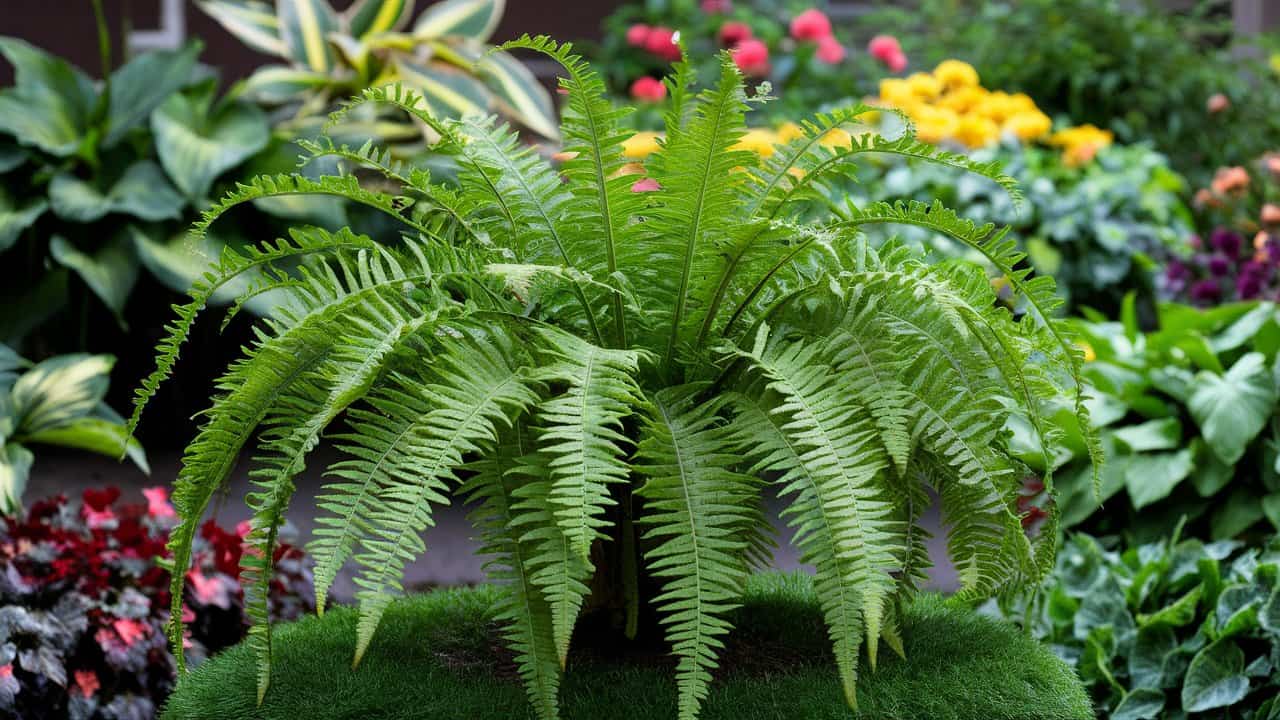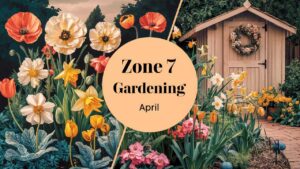When it comes to gardening, finding the right plants for shaded areas can be a challenge. Many common garden plants thrive in full sun, leaving gardeners with limited options for those hard-to-fill, dark corners of the yard. However, there are a variety of beautiful and resilient plants that not only tolerate shade but actually prefer it. In this blog post, we’ll explore four fantastic shade-loving plants that can transform your garden.
Coleus
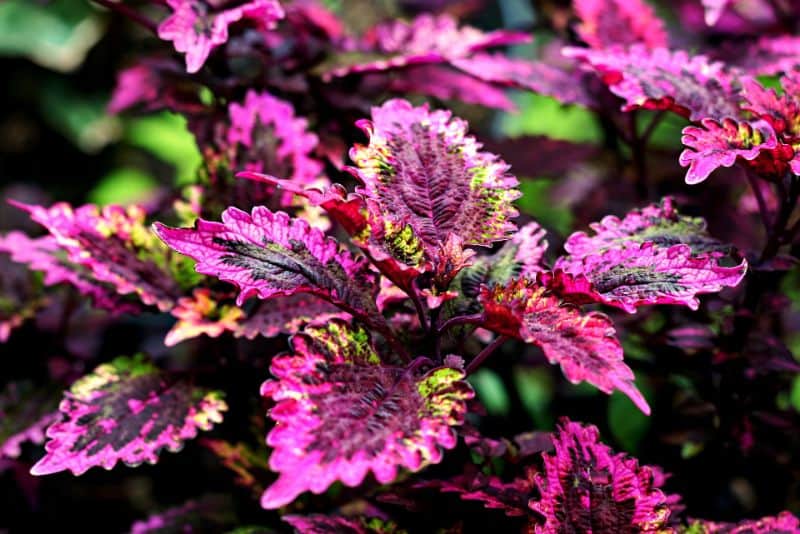
Coleus is a true standout when it comes to shade-loving plants. This vibrant annual boasts an incredible array of leaf colors and patterns, ranging from deep burgundy and purple to bright chartreuse and variegated hues. Coleus plants thrive in partial to full shade, making them an excellent choice for areas that receive limited direct sunlight.
One of the best things about coleus is its versatility. These plants can be used as bedding, in containers, or as accents in mixed borders. Their compact, mounding habit and diverse foliage make them a perfect complement to other shade-loving perennials. Coleus also requires minimal maintenance, making it a low-effort addition to any shaded garden.
Astilbe
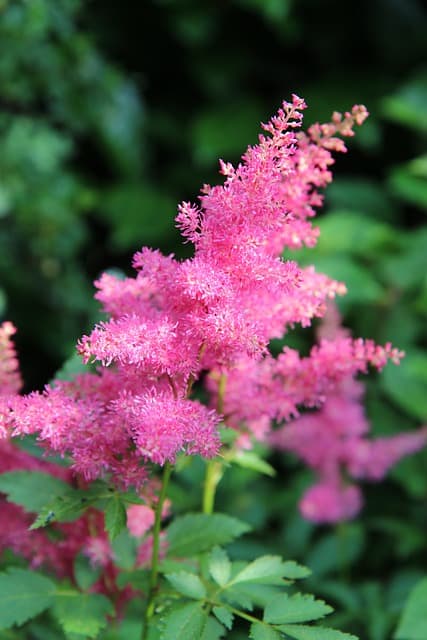
Astilbe, also known as false goat’s beard, is a graceful perennial that adds a touch of elegance to shaded areas. These plants produce lush, fern-like foliage and stunning plumes of delicate flowers that range in color from white and pink to deep red and purple. Astilbe prefers partial to full shade and moist, well-drained soil, making it an ideal choice for damp, wooded areas or along the edges of ponds and streams.
One of the standout features of astilbe is its ability to bloom for an extended period, often from late spring through midsummer. This makes it a valuable addition to the shade garden, providing color and interest long after many other plants have finished flowering. Astilbe also works beautifully in cut flower arrangements, adding a touch of whimsy and romance.
Hosta
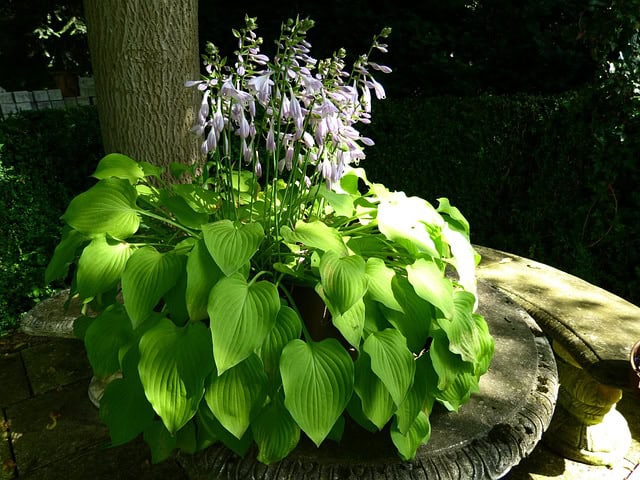
Hosta, often referred to as the “queen of the shade garden,” is a beloved perennial known for its diverse foliage and tolerance for low-light conditions. These plants come in a wide variety of sizes, shapes, and colors, from the large, bold-leaved varieties to the more delicate, miniature types.
Hostas thrive in partial to full shade and prefer moist, well-drained soil. They make excellent ground covers, border plants, and focal points in shaded garden beds. One of the best things about hostas is their ability to tolerate a range of soil conditions, making them a versatile choice for gardeners with challenging growing environments.
In addition to their ornamental foliage, hostas also produce lovely, fragrant flowers in the summer, adding an extra layer of interest to the shade garden.
Hellebore
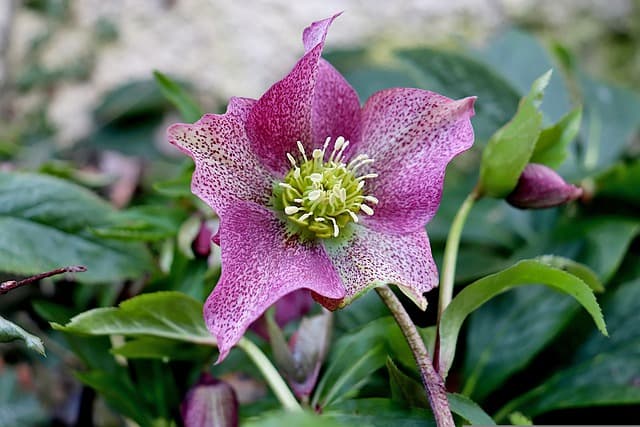
Hellebore, also known as the Christmas rose or Lenten rose, is a unique perennial that brings a touch of elegance to shaded areas. These plants are known for their early spring blooms, which often appear as early as late winter or early spring, making them a valuable addition to the garden when little else is in flower.
Hellebores prefer partial to full shade and well-drained, humus-rich soil. They come in a variety of colors, including white, pink, purple, and even green, and their nodding, cup-shaped flowers add a touch of whimsy to the shade garden.
One of the best things about hellebores is their long-lasting blooms, which can persist for several months. They also make excellent cut flowers, adding a touch of sophistication to indoor arrangements.
Begonia
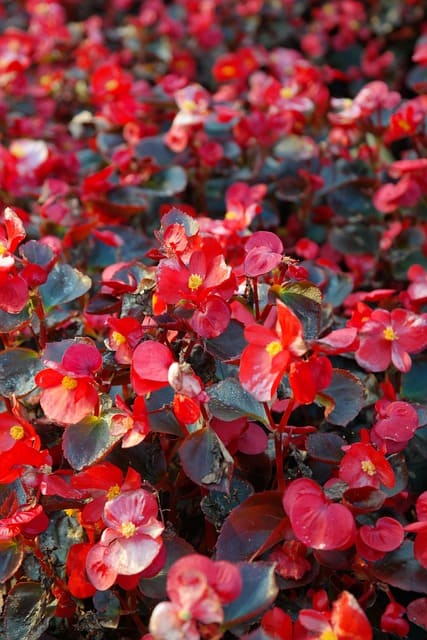
Begonias are a versatile and vibrant group of plants that thrive in partial to full shade. These plants come in a wide range of sizes, shapes, and colors, making them a valuable addition to any shade garden. From the towering, cane-type begonias to the more compact, fibrous-rooted varieties, there’s a begonia to suit every gardener’s needs.
One of the standout features of begonias is their stunning foliage, which can range from deep green to bronze, burgundy, and even variegated hues. Many begonia varieties also produce an abundance of colorful, showy flowers that add a pop of color to the shade garden. These plants prefer moist, well-drained soil and thrive in areas with high humidity, making them an excellent choice for damp, shaded corners.
Coral Bells (Heuchera)
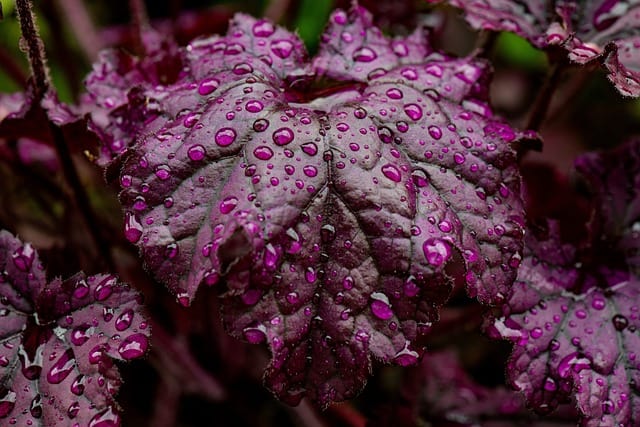
Coral bells, also known as heuchera, are a perennial favorite for the shade garden. These plants are prized for their diverse and often eye-catching foliage, which can range from deep purple and burgundy to vibrant greens and even silver-toned hues. Many coral bell varieties also produce delicate, airy flower spikes that add an extra layer of interest to the garden.
Coral bells prefer partial to full shade and well-drained, moist soil. They make excellent ground covers, border plants, and accent pieces in mixed shade gardens. One of the best things about coral bells is their ability to tolerate a wide range of soil conditions, making them a versatile choice for gardeners with challenging growing environments.
Bleeding Heart
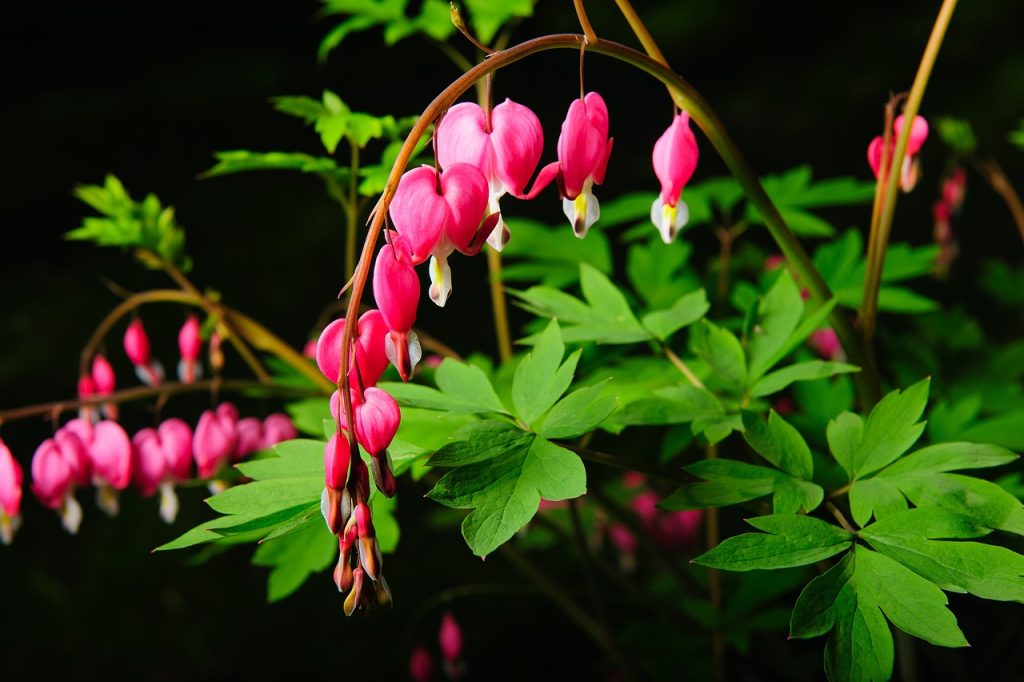
Bleeding heart is a classic shade-loving perennial that adds a touch of whimsy and romance to the garden. These plants are known for their unique, heart-shaped flowers that dangle gracefully from arching stems, creating a captivating display.
Bleeding hearts prefer partial to full shade and moist, well-drained soil. They are particularly well-suited for woodland gardens, shaded borders, and areas with dappled sunlight. One of the standout features of bleeding heart is its ability to bloom for an extended period, often from late spring through early summer.
In addition to their stunning flowers, bleeding hearts also boast attractive, fern-like foliage that provides a lush, textural element to the shade garden.
Columbine
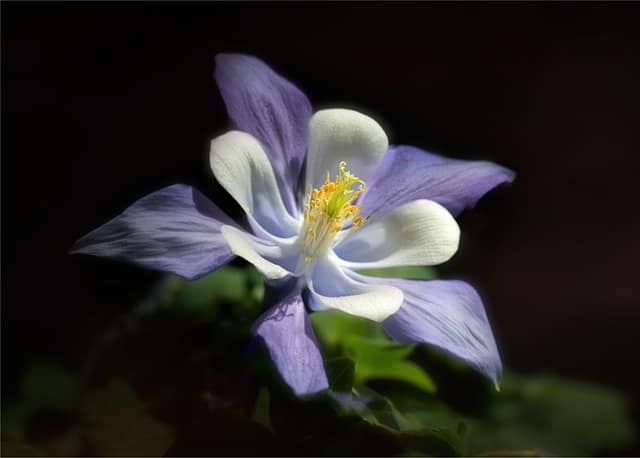
Columbine, also known as aquilegia, is a delicate and charming perennial that thrives in partial to full shade. These plants are known for their unique, spurred flowers that come in a variety of colors, including white, pink, purple, and yellow.
Columbine prefers well-drained, moist soil and partial shade, making it an excellent choice for areas with dappled sunlight or under the canopy of taller plants. These plants self-seed readily, allowing them to spread and naturalize throughout the garden, creating a whimsical, cottage-style display.
In addition to their eye-catching flowers, columbine also boasts attractive, finely-cut foliage that provides a lovely contrast to the larger-leaved plants often found in shade gardens.
Lungwort
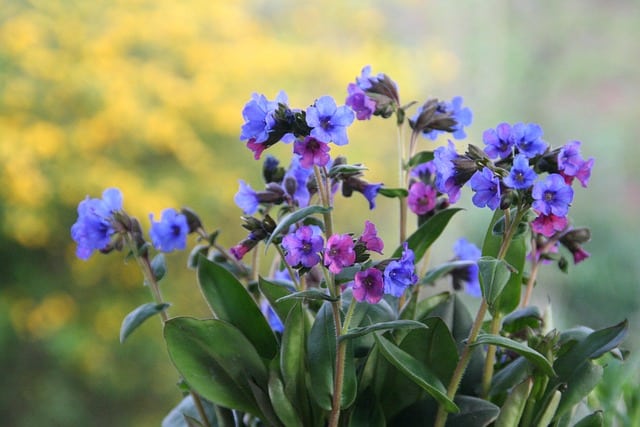
Lungwort, also known as Pulmonaria, is a charming perennial that thrives in partial to full shade. These plants are known for their distinctive, spotted leaves that resemble the human lung, hence the common name. Lungwort also produces clusters of delicate, bell-shaped flowers that range in color from pink and purple to blue and white.
One of the standout features of lungwort is its ability to bloom early in the spring, providing a welcome burst of color in the shade garden when few other plants are in flower. These plants prefer moist, well-drained soil and do best in areas with dappled sunlight or partial shade.
Lungwort makes an excellent ground cover, border plant, or accent piece in mixed shade gardens. Its unique foliage and long-lasting blooms make it a valuable addition to any shaded landscape.
Foxglove
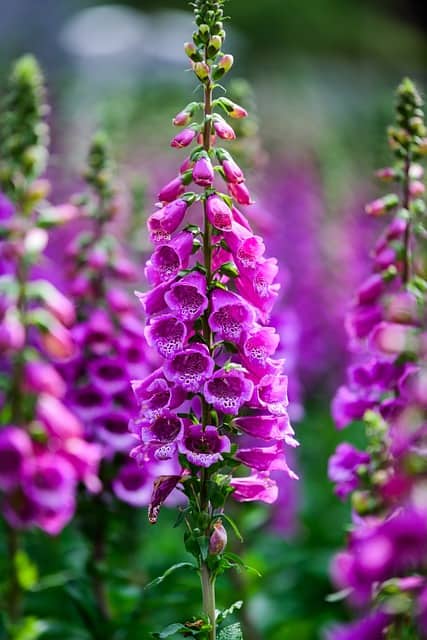
Foxglove, with its towering spikes of bell-shaped flowers, is a true showstopper in the shade garden. These biennial plants come in a range of colors, including white, pink, purple, and yellow, and their tall, stately presence adds a touch of drama to any shaded area.
Foxgloves prefer partial to full shade and well-drained, moist soil. They are particularly well-suited for woodland gardens, shaded borders, and areas with dappled sunlight. One of the best things about foxgloves is their ability to self-seed, allowing them to naturalize and spread throughout the garden over time.
In addition to their stunning flowers, foxgloves also boast attractive, textured foliage that provides a lush, architectural element to the shade garden. Just be mindful that all parts of the plant are poisonous, so it’s essential to keep them away from curious pets and children.
Hydrangea
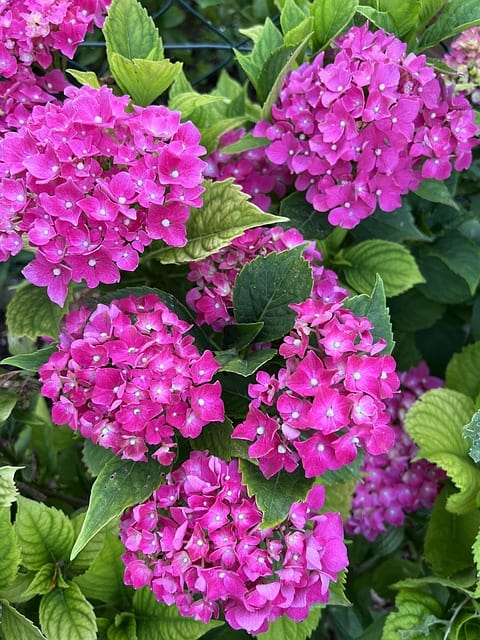
Hydrangeas are a beloved and versatile group of plants that thrive in partial to full shade. These shrubs are known for their large, showy flower heads that come in a range of colors, including white, pink, blue, and purple.
One of the standout features of hydrangeas is their ability to adapt to different soil conditions. While they prefer moist, well-drained soil, many varieties can tolerate a range of pH levels, allowing gardeners to adjust the flower color to their liking.
Hydrangeas make excellent foundation plants, border shrubs, and specimen pieces in shaded gardens. Their lush, green foliage and long-lasting blooms provide a beautiful backdrop for other shade-loving perennials and annuals.
Rodgers Flower (Rodgersia pinnata)
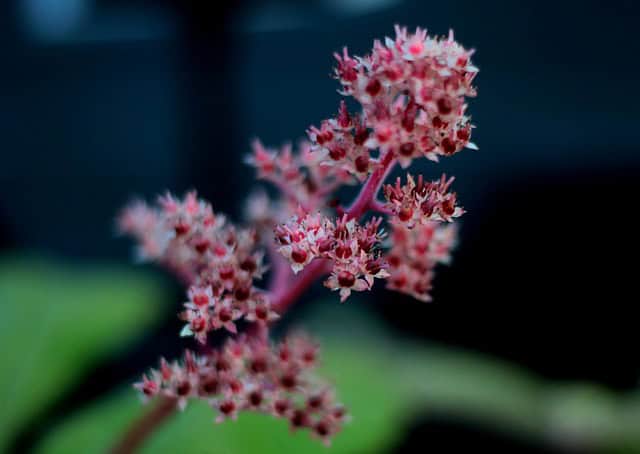
Rodgers flower, also known as Rodgersia, is a striking perennial that thrives in partial to full shade. These plants are known for their large, bold leaves that resemble those of the horse chestnut tree, creating a dramatic and architectural presence in the garden.
In addition to their impressive foliage, Rodgers flowers also produce clusters of delicate, creamy-white blooms that rise above the foliage, adding an extra layer of interest to the shade garden.
Rodgersia prefers moist, well-drained soil and partial shade, making it an excellent choice for damp, wooded areas or along the edges of ponds and streams. These plants also work well as accent pieces, border plants, or in mixed shade gardens, where their bold, textural leaves can provide a stunning contrast to other, more delicate shade-loving plants.
By incorporating these four additional shade-loving plants – lungwort, foxglove, hydrangea, and Rodgers flower – into your garden, you can create a truly diverse and visually stunning shaded oasis. Whether you’re looking to add early spring color, towering drama, or bold, architectural foliage, these versatile plants are sure to delight.
Flowering Ginger (Hedychium)
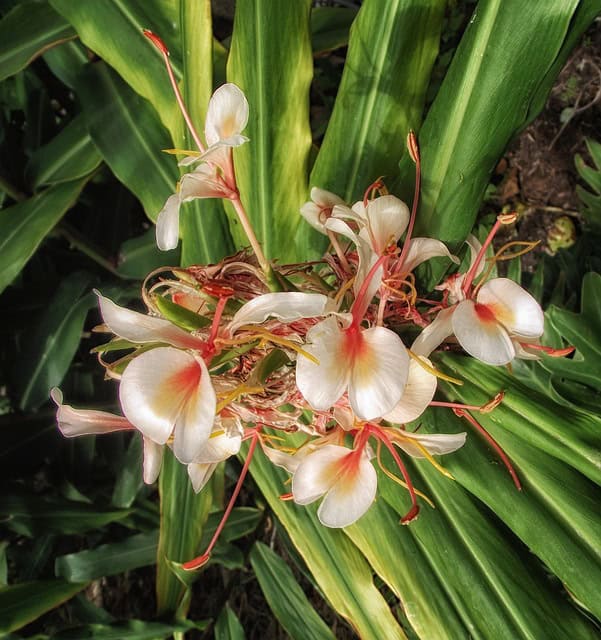
Flowering ginger, also known as Hedychium, is a tropical-looking perennial that thrives in partial to full shade. These plants are known for their large, lush foliage and stunning, fragrant flowers that resemble those of their culinary cousin, the common ginger plant.
Hedychium comes in a variety of species and cultivars, with blooms ranging in color from bright yellow and orange to deep red and pink. These plants prefer moist, well-drained soil and do best in areas with high humidity and partial shade.
One of the standout features of flowering ginger is its ability to add a touch of the exotic to the shade garden. Its large, bold leaves and showy flowers create a dramatic and eye-catching display, making it an excellent choice for adding a tropical flair to shaded areas.
Daylily
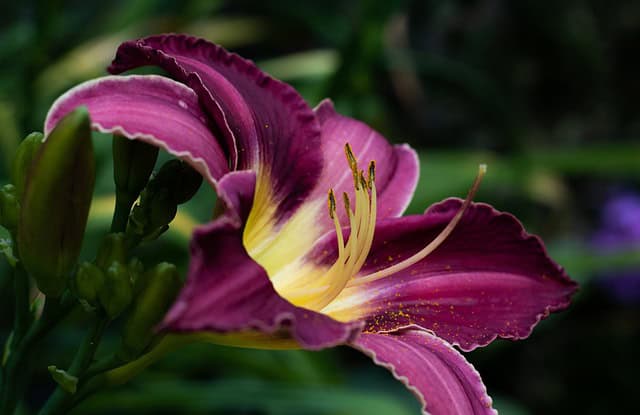
Daylilies are a versatile and resilient group of plants that can thrive in partial to full shade. While they are often associated with sunny, open areas, many daylily varieties are well-suited for shaded gardens, providing a burst of color and interest.
These perennials come in a wide range of colors, from vibrant reds and oranges to delicate pastels and bicolors. Daylilies also boast attractive, strap-like foliage that provides a lush, textural element to the shade garden.
One of the best things about daylilies is their ability to tolerate a variety of soil conditions, making them a low-maintenance addition to any shaded landscape. They also produce an abundance of flowers, with each bloom lasting for a single day, hence the common name “daylily.”
Yellow Corydalis
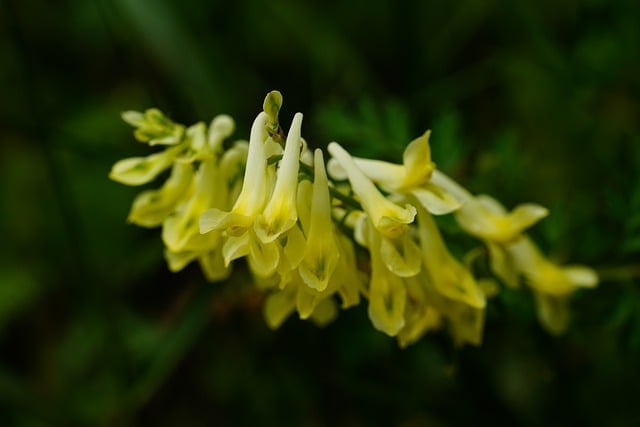
Yellow corydalis, also known as Corydalis lutea, is a delicate and charming perennial that thrives in partial to full shade. These plants are known for their fern-like foliage and clusters of bright yellow, spurred flowers that bloom from late spring through early fall.
Yellow corydalis prefers well-drained, moist soil and partial shade, making it an excellent choice for areas with dappled sunlight or under the canopy of taller plants. These plants self-seed readily, allowing them to spread and naturalize throughout the garden, creating a whimsical, cottage-style display.
In addition to their eye-catching flowers, yellow corydalis also boasts attractive, finely-cut foliage that provides a lovely contrast to the larger-leaved plants often found in shade gardens.
Spotted Dead Nettle
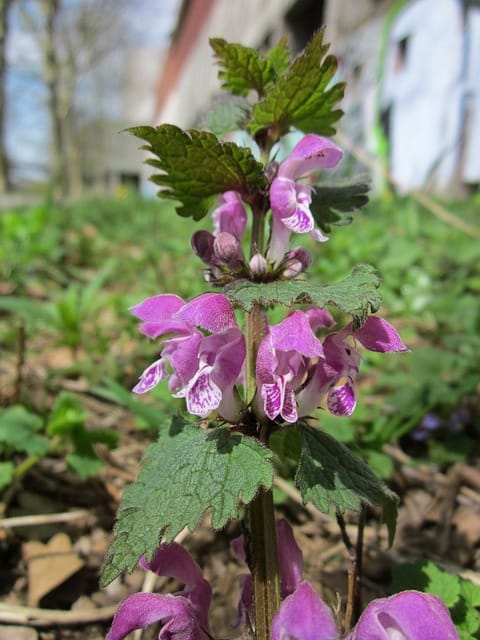
Spotted dead nettle, or Lamium maculatum, is a low-growing, spreading perennial that thrives in partial to full shade. These plants are known for their distinctive, variegated leaves that feature a silvery-white pattern, creating a striking contrast against the deep green foliage.
In addition to their attractive foliage, spotted dead nettles also produce clusters of small, tubular flowers that range in color from white and pink to purple. These plants prefer moist, well-drained soil and do best in areas with partial shade or dappled sunlight.
Spotted dead nettles make excellent ground covers, border plants, and edging for shaded gardens. Their low-growing, spreading habit allows them to fill in gaps and provide a lush, textural element to the landscape.
Turtlehead
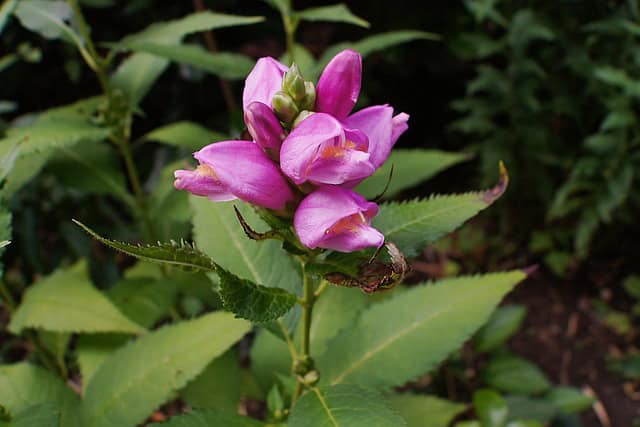
Turtlehead, or Chelone, is a perennial that thrives in partial to full shade. These plants are known for their unique, hooded flowers that resemble the head of a turtle, hence the common name.
Turtlehead comes in a variety of species and cultivars, with blooms ranging in color from white and pink to deep purple and red. These plants prefer moist, well-drained soil and do best in areas with partial shade or dappled sunlight.
One of the standout features of turtlehead is its ability to bloom in late summer and early fall, providing a welcome burst of color in the shade garden when many other plants have finished flowering. The plants’ sturdy, upright stems and glossy, dark green foliage also make them an attractive addition to any shaded landscape.
Aster
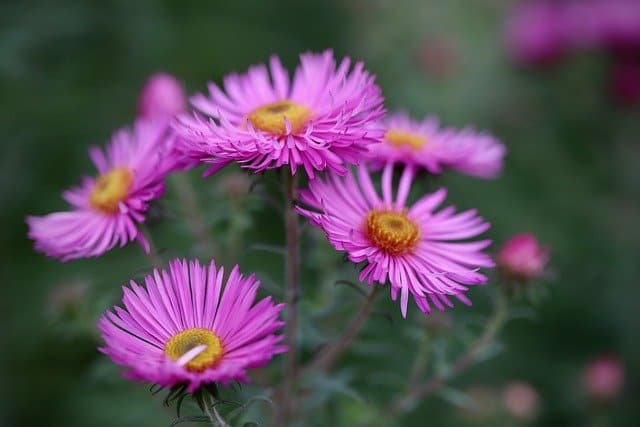
Aster is a versatile and vibrant perennial that can thrive in partial to full shade. While these plants are often associated with sunny, open areas, many aster varieties are well-suited for shaded gardens, providing a stunning display of late-season color.
Asters come in a wide range of sizes, shapes, and colors, from the delicate, daisy-like blooms of the New England aster to the bold, fluffy flowers of the Symphyotrichum cultivars. These plants prefer moist, well-drained soil and do best in areas with partial shade or dappled sunlight.
One of the best things about asters is their ability to attract a variety of pollinators, including bees, butterflies, and hummingbirds, making them a valuable addition to any wildlife-friendly garden.
Lady’s Mantle
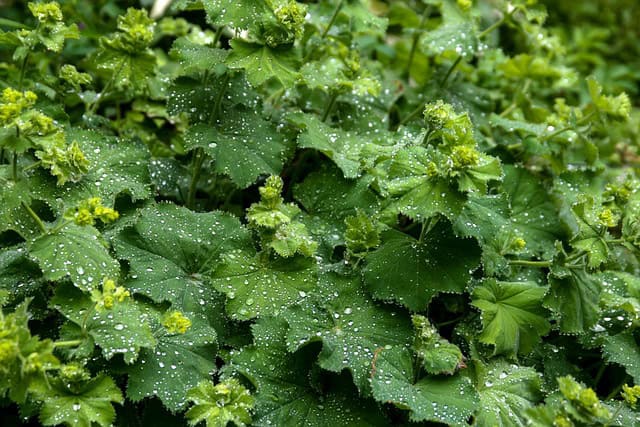
Lady’s mantle, or Alchemilla, is a charming and versatile perennial that thrives in partial to full shade. These plants are known for their distinctive, scalloped leaves that capture raindrops, creating a sparkling, jewel-like effect in the garden.
In addition to their attractive foliage, lady’s mantle also produces clusters of tiny, chartreuse-colored flowers that bloom in early to mid-summer. These plants prefer moist, well-drained soil and do best in areas with partial shade or dappled sunlight.
Lady’s mantle makes an excellent ground cover, border plant, or accent piece in shaded gardens. Its low-growing, spreading habit allows it to fill in gaps and provide a lush, textural element to the landscape.
St. John’s Wort
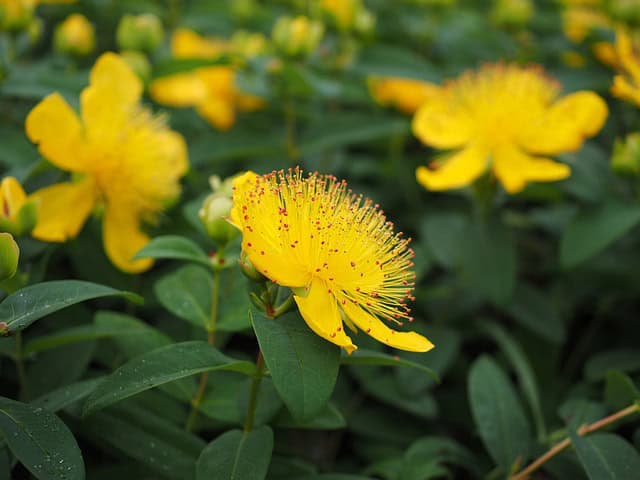
St. John’s Wort, or Hypericum, is a hardy and versatile perennial that can thrive in partial to full shade. These plants are known for their bright, cheerful flowers that bloom in a range of colors, including yellow, orange, and red.
In addition to their eye-catching blooms, St. John’s Wort also boasts attractive, glossy foliage that provides a lush, textural element to the shade garden. These plants prefer well-drained, moist soil and do best in areas with partial shade or dappled sunlight.
One of the standout features of St. John’s Wort is its ability to tolerate a wide range of soil conditions, making it a versatile choice for gardeners with challenging growing environments. These plants also self-seed readily, allowing them to spread and naturalize throughout the garden.
Allium
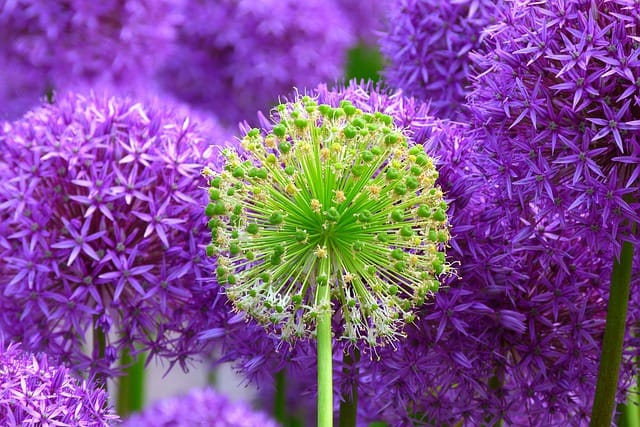
Allium, a member of the onion family, is a versatile and eye-catching perennial that can thrive in partial to full shade. These plants are known for their distinctive, globe-shaped flower heads that bloom in a range of colors, including purple, white, and pink.
While alliums are often associated with sunny, open areas, many varieties are well-suited for shaded gardens, providing a striking contrast to the typically more delicate shade-loving plants. These plants prefer well-drained, nutrient-rich soil and do best in areas with partial shade or dappled sunlight.
One of the standout features of alliums is their ability to add vertical interest to the shade garden, with their tall, slender stems rising above the surrounding foliage. These plants also have the added benefit of being deer-resistant, making them a valuable choice for gardeners dealing with pesky herbivores.
Bigroot Geranium
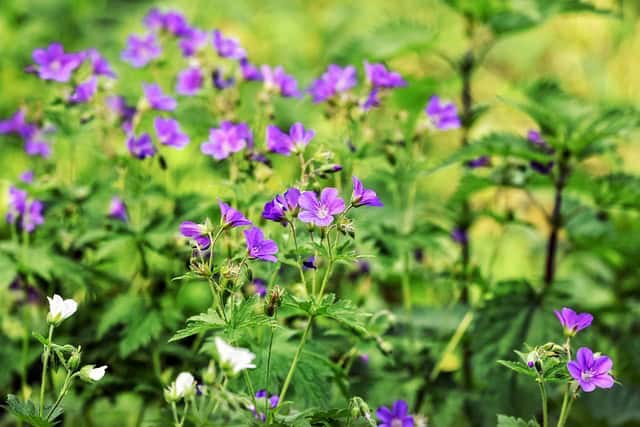
Bigroot geranium, or Geranium macrorrhizum, is a hardy and versatile perennial that thrives in partial to full shade. These plants are known for their deeply lobed, aromatic foliage that turns a beautiful shade of red or bronze in the fall.
In addition to their attractive leaves, bigroot geraniums also produce clusters of delicate, pink or white flowers that bloom in late spring and early summer. These plants prefer well-drained, moist soil and do best in areas with partial shade or dappled sunlight.
One of the standout features of bigroot geraniums is their ability to spread and form a dense, carpet-like ground cover, making them an excellent choice for filling in gaps and covering bare soil in shaded areas. These plants are also deer-resistant, adding to their appeal for gardeners dealing with pesky herbivores.
Toad Lily
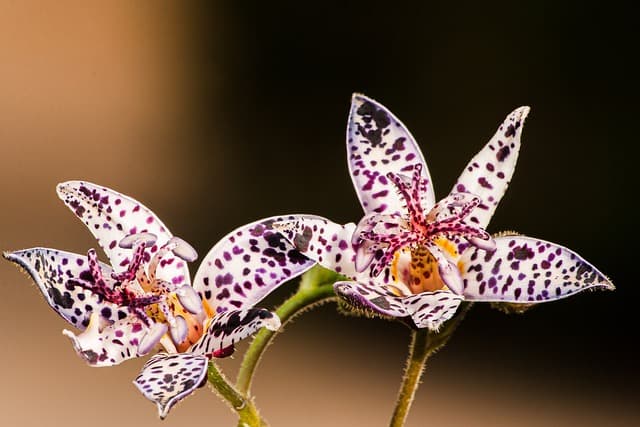
Toad lily, or Tricyrtis, is a unique and captivating perennial that thrives in partial to full shade. These plants are known for their distinctive, orchid-like flowers that bloom in late summer and fall, providing a welcome burst of color when many other plants have finished flowering.
Toad lilies come in a variety of species and cultivars, with blooms ranging in color from white and pink to purple and yellow. These plants prefer moist, well-drained soil and do best in areas with partial shade or dappled sunlight.
One of the standout features of toad lilies is their ability to add a touch of the exotic to the shade garden, with their intricate, spotted flowers and lush, tropical-looking foliage. These plants also make excellent cut flowers, adding a unique and eye-catching element to floral arrangements.
Cardinal Flower
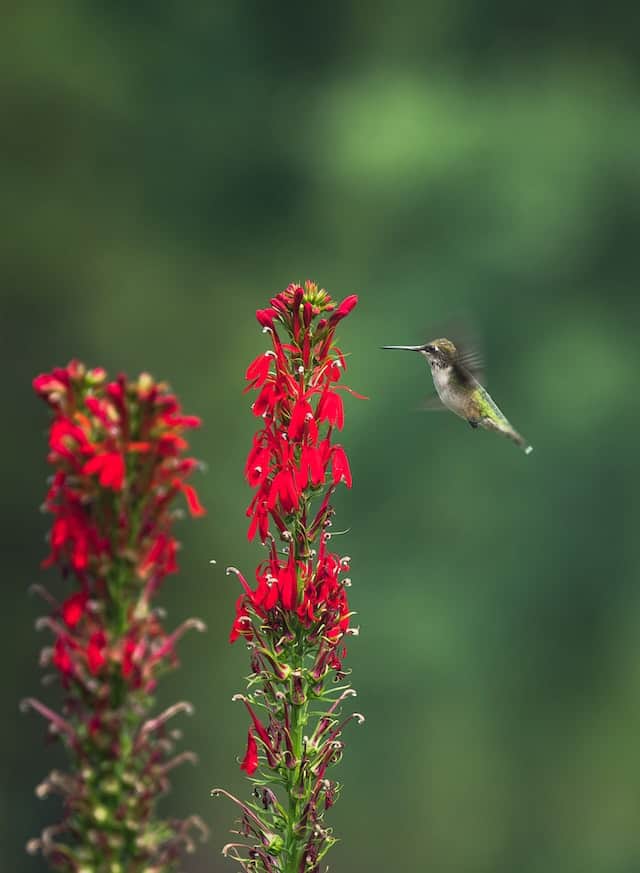
Cardinal flower, or Lobelia cardinalis, is a vibrant and eye-catching perennial that thrives in partial to full shade. These plants are known for their bold, scarlet-red flowers that bloom in late summer and early fall, providing a stunning contrast to the typically more muted shaded garden.
Cardinal flowers prefer moist, well-drained soil and do best in areas with partial shade or dappled sunlight. These plants are also known for their ability to attract hummingbirds, making them a valuable addition to any wildlife-friendly garden.
One of the standout features of cardinal flowers is their ability to add a touch of drama and intensity to the shade garden. Their tall, upright stems and striking, tubular blooms create a bold and commanding presence, making them a must-have for gardeners looking to make a statement.
Carpathian Bellflower
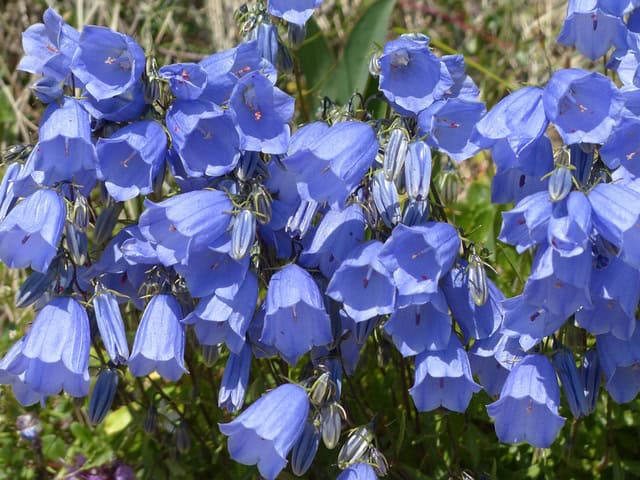
Carpathian bellflower, or Campanula carpatica, is a delicate and charming perennial that thrives in partial to full shade. These plants are known for their delicate, bell-shaped flowers that bloom in a range of colors, including white, blue, and purple.
Carpathian bellflowers prefer well-drained, moist soil and do best in areas with partial shade or dappled sunlight. These plants are also known for their ability to form dense, carpet-like groundcovers, making them an excellent choice for filling in gaps and covering bare soil in the shade garden.
One of the standout features of Carpathian bellflowers is their long-blooming period, with flowers appearing from late spring through early fall. This extended flowering season adds a touch of whimsy and color to the shaded landscape.
Hardy Geranium (Cranesbill Geranium)
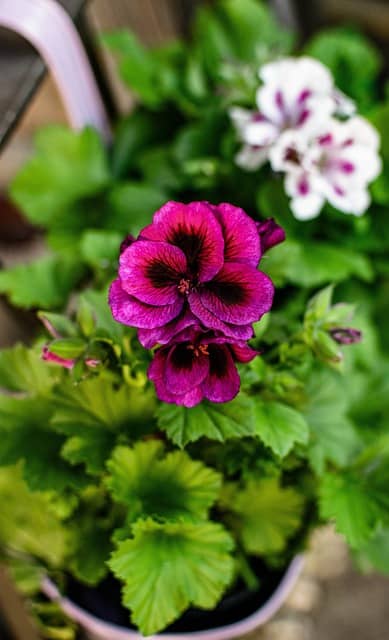
Hardy geranium, or Cranesbill geranium, is a versatile and resilient perennial that can thrive in partial to full shade. These plants are known for their delicate, saucer-shaped flowers that bloom in a range of colors, including pink, purple, and white.
In addition to their eye-catching blooms, hardy geraniums also boast attractive, deeply lobed foliage that provides a lush, textural element to the shade garden. These plants prefer well-drained, moist soil and do best in areas with partial shade or dappled sunlight.
One of the standout features of hardy geraniums is their ability to spread and form a dense, carpet-like ground cover, making them an excellent choice for filling in gaps and covering bare soil in the shade garden. These plants are also known for their long-blooming period, with flowers appearing from late spring through early fall.
Spiderwort
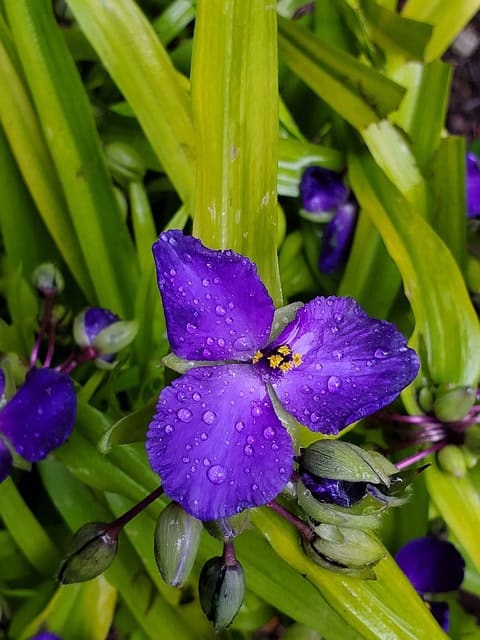
Spiderwort, or Tradescantia, is a versatile and eye-catching perennial that thrives in partial to full shade. These plants are known for their distinctive, three-petaled flowers that bloom in a range of colors, including purple, blue, and pink.
Spiderworts prefer well-drained, moist soil and do best in areas with partial shade or dappled sunlight. These plants are also known for their ability to spread and form dense, carpet-like groundcovers, making them an excellent choice for filling in gaps and covering bare soil in the shade garden.
One of the standout features of spiderworts is their long-blooming period, with flowers appearing from late spring through early fall. This extended flowering season adds a touch of whimsy and color to the shaded landscape.
Actaea

Actaea, also known as baneberry or cohosh, is a striking and unique perennial that thrives in partial to full shade. These plants are known for their distinctive, feathery foliage and clusters of small, white or pink flowers that bloom in late spring and early summer.
Actaea prefers well-drained, moist soil and does best in areas with partial shade or dappled sunlight. These plants are also known for their ability to add a touch of the exotic to the shade garden, with their lush, tropical-looking foliage and delicate blooms.
One of the standout features of actaea is its ability to provide year-round interest, with its attractive foliage and striking seed heads that develop after the flowers have faded. These plants also make excellent companions for other shade-loving perennials, adding a touch of contrast and texture to the overall design.
Fuchsia

Fuchsia is a delicate and enchanting perennial that can thrive in partial to full shade. These plants are known for their distinctive, pendulous flowers that come in a range of colors, including pink, purple, and red.
Fuchsias prefer well-drained, moist soil and do best in areas with partial shade or dappled sunlight. These plants are also known for their ability to add a touch of the tropics to the shade garden, with their lush, verdant foliage and eye-catching blooms.
One of the standout features of fuchsias is their ability to provide a long-lasting display of color, with flowers appearing from late spring through early fall. These plants also make excellent container plants, allowing gardeners to bring their enchanting beauty to shaded patios and balconies.
Pachysandra
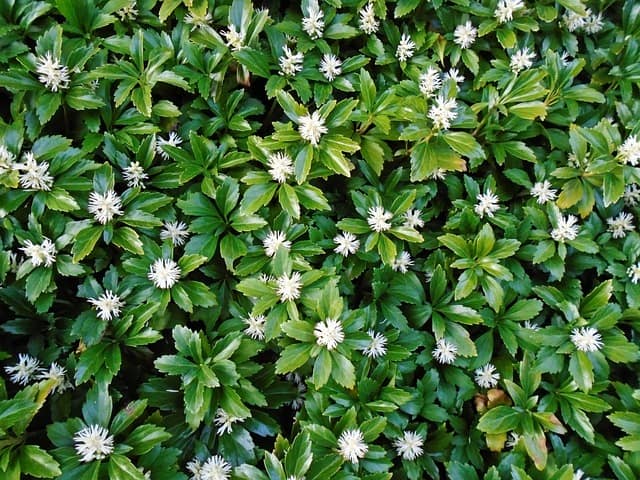
Pachysandra, also known as Japanese spurge, is a low-growing, evergreen groundcover that thrives in partial to full shade. These plants are known for their glossy, dark green foliage that provides a lush, textural element to the shaded landscape.
Pachysandra prefers well-drained, moist soil and does best in areas with partial shade or dappled sunlight. These plants are also known for their ability to spread and form dense, carpet-like groundcovers, making them an excellent choice for covering bare soil and filling in gaps in the shade garden.
One of the standout features of pachysandra is its ability to provide year-round interest, with its evergreen foliage adding a touch of life and vibrancy to the shaded landscape, even during the winter months. These plants also make excellent companions for other shade-loving perennials, providing a lush and cohesive backdrop for their more delicate blooms.
Sweet Alyssum

Sweet alyssum, or Lobularia maritima, is a delicate and charming annual that can thrive in partial to full shade. These plants are known for their small, fragrant flowers that bloom in a range of colors, including white, purple, and pink.
Sweet alyssum prefers well-drained, moist soil and does best in areas with partial shade or dappled sunlight. These plants are also known for their ability to self-seed and spread, making them an excellent choice for filling in gaps and creating a lush, carpet-like groundcover in the shade garden.
One of the standout features of sweet alyssum is its ability to provide a long-lasting display of color and fragrance, with flowers appearing from late spring through early fall. These plants also make excellent companions for other shade-loving perennials, adding a touch of delicacy and charm to the overall design.
Foamflower
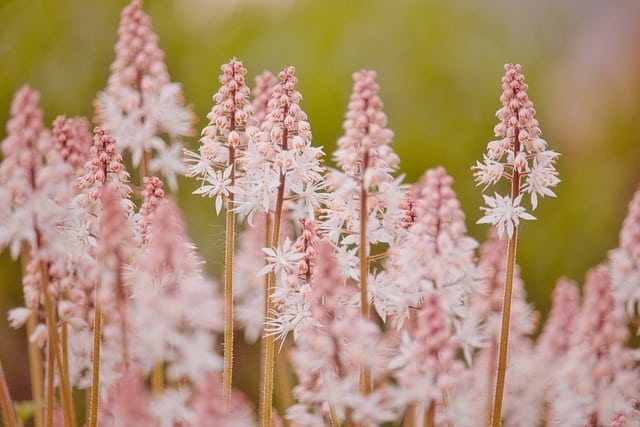
Foamflower, or Tiarella, is a delicate and charming perennial that thrives in partial to full shade. These plants are known for their distinctive, lobed foliage that comes in a range of colors, including green, bronze, and purple.
In addition to their eye-catching leaves, foamflowers also produce delicate, tiny flowers that bloom in the spring and early summer, adding a touch of whimsy to the shaded landscape. These plants prefer well-drained, moist soil and do best in areas with partial shade or dappled sunlight.
One of the standout features of foamflowers is their ability to provide year-round interest in the shade garden, with their vibrant foliage and delicate blooms. These plants also make excellent companions for other shade-loving perennials, adding a touch of contrast and texture to the overall design.
Climbing Hydrangeas

Climbing hydrangeas, or Hydrangea anomala subsp. petiolaris, are a unique and versatile perennial that can thrive in partial to full shade. These plants are known for their ability to climb and cling to walls, trellises, and other vertical structures, creating a stunning and eye-catching display in the shaded landscape.
In addition to their climbing habit, climbing hydrangeas also produce large, lacy flower heads that bloom in the late spring and early summer, adding a touch of elegance and charm to the shaded garden. These plants prefer well-drained, moist soil and do best in areas with partial shade or dappled sunlight.
One of the standout features of climbing hydrangeas is their ability to provide a sense of height and vertical interest in the shade garden, adding depth and dimension to the overall design. These plants also make excellent companions for other shade-loving perennials, creating a lush and cohesive tapestry of foliage and blooms.


